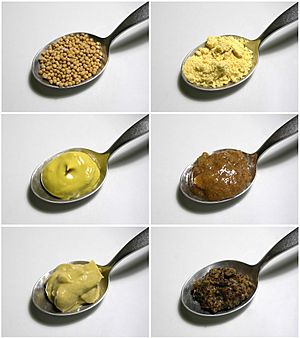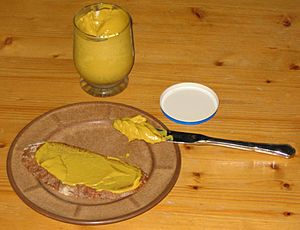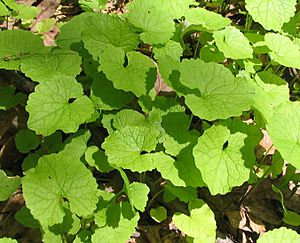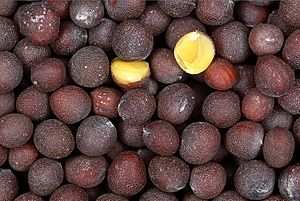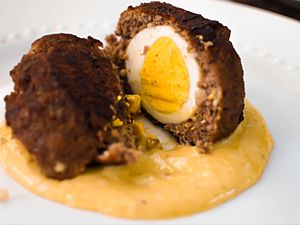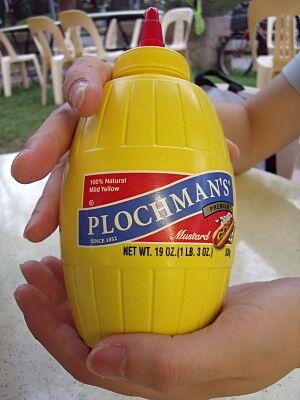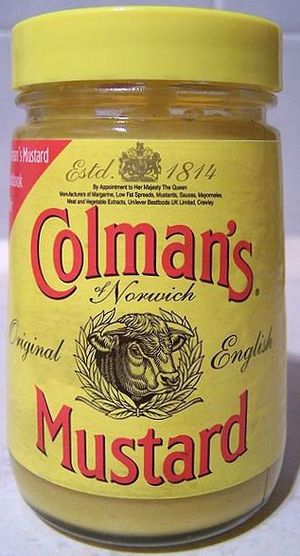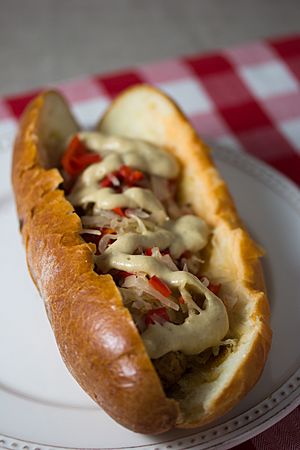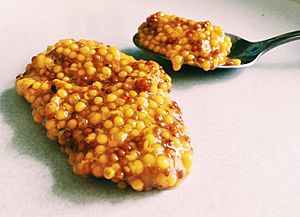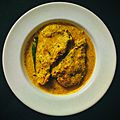Culinary mustard facts for kids
Mustard is a popular condiment made from the tiny seeds of a mustard plant. There are different types of mustard plants, like white, brown, or black mustard.
To make mustard, the seeds are crushed or ground. Then, they are mixed with liquids like water, vinegar, lemon juice, or wine. Salt and other spices are often added too. This creates a paste or sauce that can be bright yellow or dark brown. Mustard can taste sweet or very spicy!
People often eat mustard with meats and cheeses. It's great on sandwiches, hamburgers, and hot dogs. You can also find mustard in many dressings, sauces, soups, and marinades.
Mustard is used all over the world, in places like India, Europe, Asia, and the Americas. This makes it one of the most popular spices and condiments globally.
Contents
History of Mustard
People have been growing mustard for a very long time. Scientists found signs of mustard being grown in the Indus Valley (which is now part of India and Pakistan) around 1800 BC.
The Romans were probably the first to make mustard into a condiment. They mixed ground mustard seeds with grape juice to create a spicy sauce. A Roman cookbook from the 4th or 5th century even has a recipe for mustard! It included many ingredients like pepper, honey, and vinegar.
The Romans likely brought mustard seeds to Gaul (which is now France). By the 10th century, monks in Paris started making their own mustard. Dijon, France, became famous for mustard making by the 13th century.
In England, people were using mustard as a condiment by 1390. They would make "mustard balls" from ground seeds, flour, and cinnamon. These balls could be stored easily and then mixed with vinegar or wine to make a paste when needed.
In the United States, mustard became very popular with hot dogs at the 1904 St. Louis World's Fair. That's when the bright-yellow French's mustard was first introduced.
How Mustard is Used in Cooking
Mustard is often served with cold meats. It's also an ingredient in mayonnaise, vinaigrette, and barbecue sauce. Many people enjoy mustard with hot dogs, pretzels, and bratwurst. In some places, like the Netherlands, people even make mustard soup!
Mustard can also help mix oil and water together, which usually don't mix well. This is why it's used in sauces like Hollandaise sauce to keep them smooth.
What's in Mustard?
Mustard seeds contain good things like selenium and omega 3 fatty acid. As a condiment, a teaspoon of mustard has about 5 calories. You can find more details about mustard's nutrients in the USDA National Nutrient Database.
Making Mustard
There are many kinds of prepared mustards, and they all have different strengths and flavors. This depends on the type of mustard seed used and how it's made. White mustard seeds usually make a milder flavor, while black or brown seeds make a spicier mustard.
The sharp, hot taste of mustard comes from a chemical reaction when ground mustard seeds are mixed with water. This reaction creates different flavors and levels of spiciness.
Prepared mustard can also have salty, sour (from vinegar), and sweet flavors. Turmeric is often added to store-bought mustards to give them a bright yellow color.
Storing Mustard
You can buy prepared mustard in glass jars, plastic bottles, or metal tubes. Mustard doesn't need to be kept in the fridge to be safe because it has special properties that stop mold or bad bacteria from growing.
Mustard can last a very long time without going bad. However, it might dry out, lose some flavor, or turn a bit brown over time. If it dries out, you can mix in a little wine or vinegar to make it better. Sometimes, mustard might separate if stored for a long time, but you can just stir or shake it to mix it again. If it's left unrefrigerated for too long, it might get a bitter taste.
Types of Mustard
Some places are famous for their mustard. These include Dijon in France, known for medium-strength mustard, and Norwich in the United Kingdom, known for very hot mustard. Germany has hot mustards from Düsseldorf and sweet mustards from Bavaria. Tecuci mustard from Romania is a sweet kind popular in Eastern Europe.
Sometimes, mustard is cooked to make it less spicy, or it's aged to develop its flavor. Irish mustard is a whole-grain mustard mixed with whiskey, stout, or honey.
Making Mustard at Home
You can easily make hot mustard at home! Just mix "powdered mustard" (which is ground mustard seed, turmeric, and wheat flour) with water, wine, vinegar, or beer until it's the right thickness. Let it sit for about ten minutes. Homemade mustard is usually made right before eating because it's spicier but loses its strength quickly.
American Yellow Mustard
This is the most common mustard in the United States. It's a very mild mustard and is bright yellow because of turmeric powder. It was first called "cream salad mustard" when it came out in 1904.
American yellow mustard is often used on hot dogs, sandwiches, pretzels, and hamburgers. It's also an ingredient in many potato salads and barbecue sauces. People sometimes call it "hot dog mustard" or "ball park mustard."
Spicy Brown Mustard
Spicy brown mustard is also popular in the U.S. Its seeds are coarsely ground, which gives it a speckled brownish-yellow look. It's usually spicier than American yellow mustard. Some "Deli-style" mustards even have horseradish in them, making them extra spicy! A special kind from Louisiana is called Creole mustard.
Beer Mustard
Beer mustard uses beer instead of vinegar. It's thought to have started in the Midwest of the United States in the 20th century and is still a favorite there.
Dijon Mustard
Dijon mustard began in 1856 when a man named Jean Naigeon in Dijon used the sour juice of unripe grapes instead of vinegar. Today, most Dijon mustards use white wine. Even though it's called "Dijon mustard," it's not a special protected name, so it can be made anywhere. Most of it is made from Canadian mustard seeds.
Whole-Grain Mustard
In whole-grain mustard, the seeds are kept whole and mixed with other ingredients. You can get different flavors and strengths by using different kinds of mustard seeds.
English Mustard
English mustard is one of the spiciest mustards in the world. It's bright yellow and thicker than American mustard. The most famous brand is Colman's, which first made its mustard as a powder in 1814.
French Mustard
This dark brown, mild, and slightly sweet mustard is actually not from France! "French" mustard was created by Colman's in the UK in 1936. It was very popular with steak. Colman's stopped making it in 2001, but many British supermarkets still sell their own versions.
Honey Mustard
As the name suggests, honey mustard is a mix of mustard and honey, often in equal parts. It's great on sandwiches and as a dip for foods like chicken strips. You can also mix it with vinegar or olive oil to make a salad dressing.
In British cooking, English mustard mixed with honey or Demerara sugar is used to coat grilled lamb or pork chops.
Hot Pepper Mustard
Different kinds of Chili peppers are used to make mustards spicier than plain mustard. Peppers or hot sauce made from peppers are added to various mustard styles, like yellow or brown mustards.
Fruit Mustards
People have been combining fruit and mustard since the 14th century! Large pieces of fruit preserved in a sweet, hot mustard syrup were served with meat. Some traditional fruit mustards include apple mustard, quince mustard (which looks like jam), and cherry mustard.
Hot Mustard
The term hot mustard means that the mustard is made to bring out the natural spiciness of the mustard seeds. This is done by using pungent black or brown mustard seeds instead of the milder white mustard seeds.
Spirited Mustards
Spirited mustards are made with alcoholic spirits. Examples include mustards with whisky, brandied peach mustard, cognac mustard, and Jack Daniel's mustard.
Sweet Mustard
Sweet mustard comes from Bavaria, Germany. It's made from crushed mustard seeds and sweetened with sugar, apple sauce, or honey.
Mustard in India
Brown mustard is a very important spice used in the Indian subcontinent today. Kasundi is a popular spicy mustard relish from Bengal. People eat it with regular meals and with fruits or street food.
Allergies to Mustard
Strong mustard can make your eyes water and sting your tongue and throat. Homemade mustards can be even hotter and more flavorful than store-bought ones.
Rarely, some people can have allergic reactions to any part of the mustard plant. These reactions can sometimes be serious. Because of this, since 2005, pre-packed food in the European Union must say on its label if it contains mustard.
Images for kids
See also
 In Spanish: Mostaza para niños
In Spanish: Mostaza para niños


